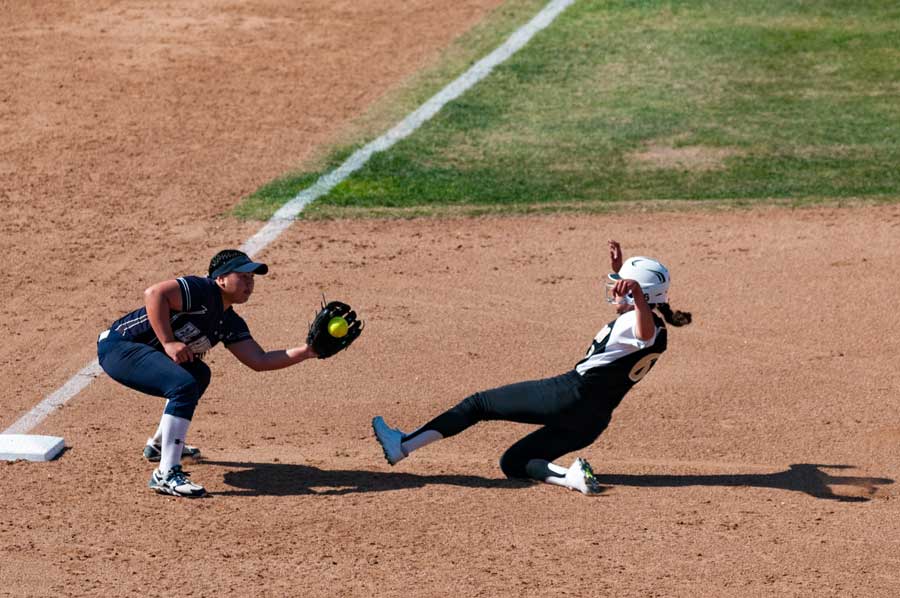
Note: This post contains affiliate product links. I may receive a commission for any purchases made through these links. You will not be charged anything by clicking on those links. For more information, read the Affiliate Disclosure.
Playing the Softball Positions
There are 10 Slowpitch softball positions, and extra player is only one of the differences between slowpitch and fastpitch softball.
In slowpitch softball, the tenth player is used as an extra outfielder, and can be utilized in two ways:
- As an outfielder – where the outfield is shared by four outfielders
- As a short fielder – or ‘rover’ who covers the gap behind the outfield and the infield, usually the area behind the shortstop position.
To help identify the softball positions when keeping score, the positions are numbered, and abbreviated. Pitcher is #1, Catcher is #2, and so on (see Diagram).
Here are the positions in numerical order:
Position Name Code
- Pitcher P
- Catcher C
- First Base 1B
- Second Base 2B
- Third Base 3B
- Short Stop SS
- Left Field LF
- Left-Center Field LC
- Right-Center Field RC
- Right Field RF
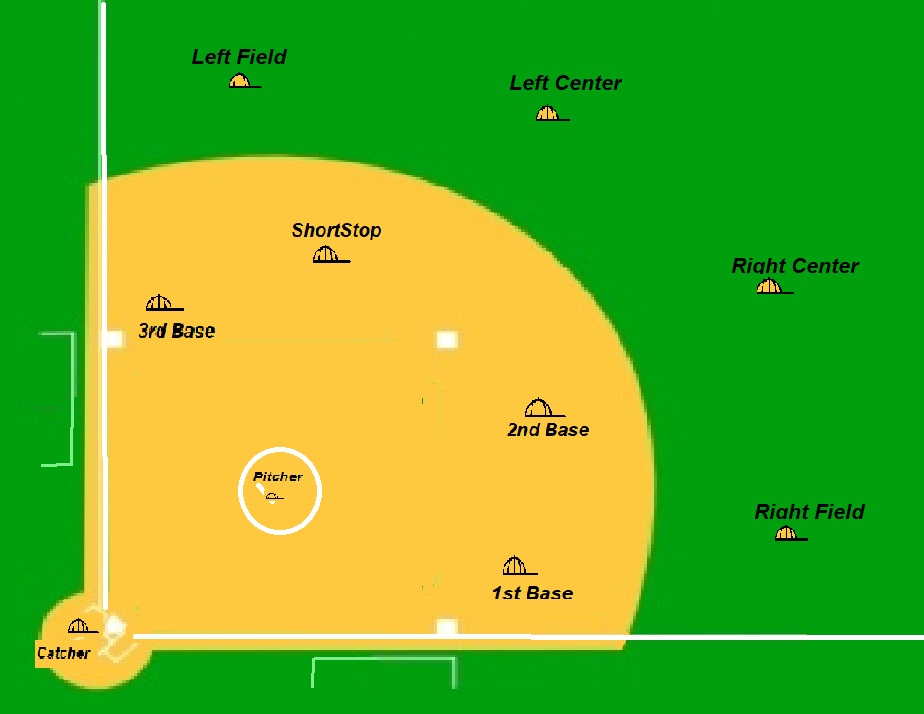
The infield softball positions
The infield is a busy place to be when the bases are full, and if a ground ball is hit to the infield, there is a lot of movement. Games have been won and lost when a play is made that puts out the runner, or when the throw is wild and runners advance and score.
(Did you ever wonder why the shortstop position is #6? See below)
In no particular order, here is a list of the positions, their duties and the skills you need to have when considering which position you want to play.
Infield Positions
First Base (1B #3)
A vital position, usually played by a tall left-handed person. Why? Because the glove is on the right hand, and gives the greatest reach span to catch a ball.
Skills recommended to play 1st Base: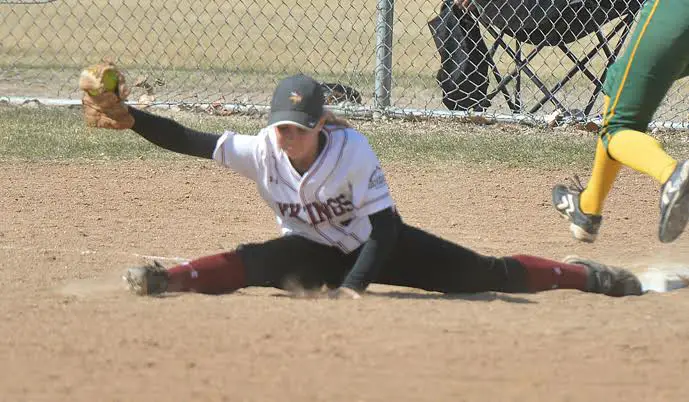
- Left-handed
- Tall
- Flexible
- Good reflexes and instincts
Gear needed to play first base: 1st Base Mitt
For slow pitch softball, you don’t have to use a first-base mitt, you can use an outfielder’s glove. Longer than the infielder glove, the outfielder glove will help you catch the ball when reaching for the throw to first base.
Equipment needed to play infield: Infielder glove.
Second Base (2B #4)
If you look at the field diagram above, you will notice the location of the bases, and the location of where that position is played.
The second base position covers the gap between the bases, and sets behind the path where the players run from base to base.
The 2nd base player needs to position themselves close enough to 2nd base in case they need to make a play, whether a tag or force out. 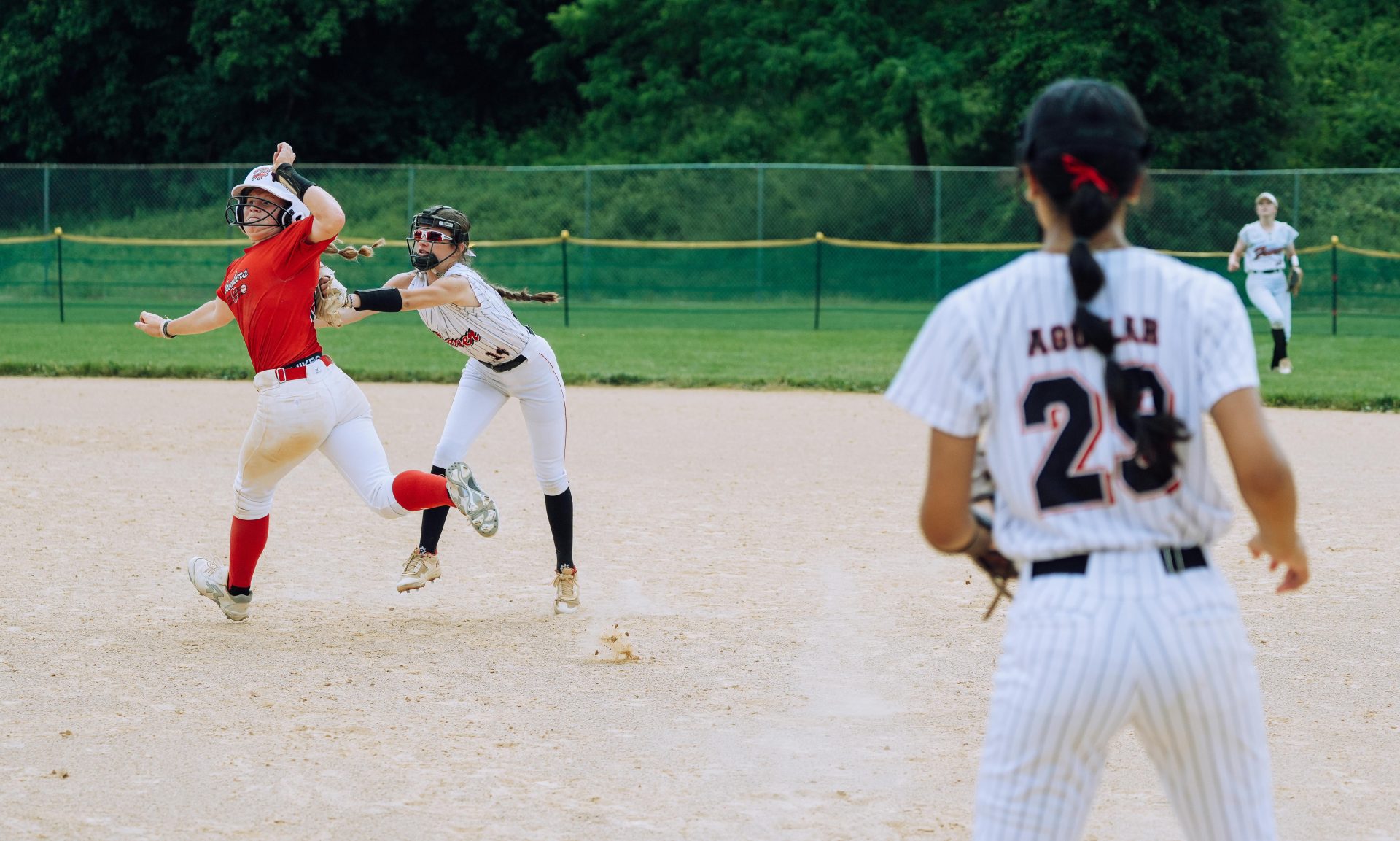
Skills recommended to play 2nd Base:
- Good hand-eye coordination
- Speed
- Agility
Third Base (3B #5)
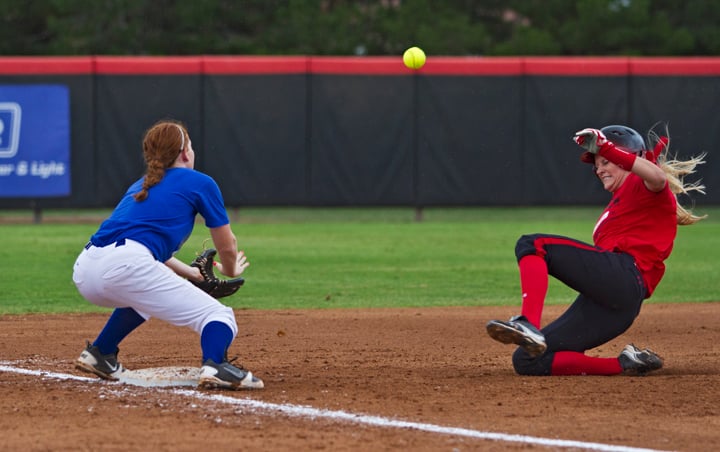
Right-handed batters ‘pull’ their swing driving the batted ball down the third base line. The 3rd base player needs to have quick reflexes and reaction time.
The diagram above shows the 3rd base person even with the bag, however, that is not always the case for slowpitch softball. The bases are only 60-70 feet away from home plate, and they usually play about five to ten feet deep behind third base.
Skills recommended to Play 3rd Base:
- Quick reflexes
- Excellent hand-eye coordination
- Throwing Accuracy
The infielder glove is designed for the infielder to grab the ball faster to make the throw to make a play.
Short Stop (Position # 6)

Ah, the Short Stop.
Originally, the Short Stop played in the gap between the outfield and the infield. As the players skills, abilities and equipment improved, the short Stop moved closer to field in the infield.
Short Stop is a demanding position; shortstops receive the majority of balls hit to the infield.
Skills needed to play Short Stop:
- Leadership Qualities
- Excellent Glove
- Excellent Arm Strength
- Excellent Agility and Range
- Strong Game Sense
Overall, the infield positions can be played by anyone who can catch and throw the ball.
When you are new to playing softball, play a few different positions and find what feels the best fit for you. Then work on improving your throwing and catching skills by practicing, watching training videos and take part in specific training when in the off-season.
Pitcher and Catcher Positions
Although the Pitcher and Catcher positions are on the infield, they are not considered as part of the infield. The slowpitch softball pitcher can determine whether you win or lose the game, based on how they deliver the pitch.
Pitcher (P #1)
Based on USA/ASA and USSSA rules, the pitched ball must arc at least 6-12 feet into the air once released from the pitcher’s hand.
Skills recommended for the Pitcher
- Fast reflexes
- Strong game knowledge
- Great hand/eye coordination
- Stay cool under pressure
The softball pitcher needs to stay consistent with their throws to prevent from walking batters.
Slowpitch softball is a hitters game, yet, the pitcher can deliver a throw that will cause even the best hitter to swing and miss the ball.
The distance between home plate and the pitcher’s mound is 50 ft. Be aware, if you want to pitch, you must have quick reflexes to field a batted ball that comes flying right back at you.
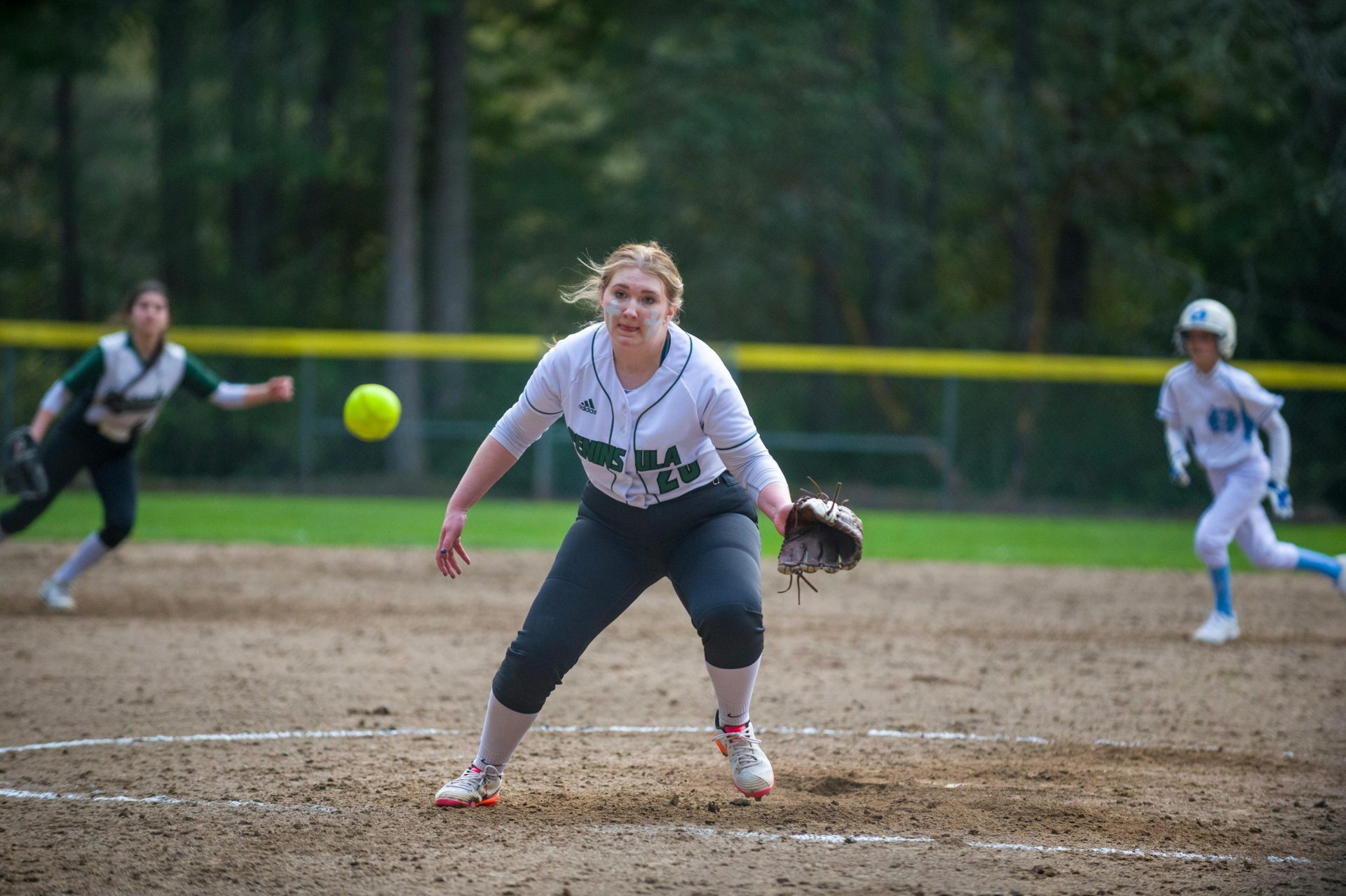
In slowpitch, the pitcher must only field balls within the 10 foot chalked circle that is around the pitchers mound. This is the pitching zone.
To go outside of the zone could interfere with the shortstop or second base infielder trying to make a play.
Equipment for the Pitcher: Infielder glove, face mask (optional)
Pitchers are a different breed of player, they need to be ready for a pitched ball to be batted right back at them. The pitcher can control the game with excellent pitching delivery.
Catcher (C #2)
The catcher receives the pitch and throws it back to the pitcher. In slowpitch, passed balls are in play and runners can advance, should the catcher miss the ball.
Catchers crouch behind home plate and wait for the pitched ball. When the ball is in play, and with runners on base, the catcher protects home plate by catching the ball and tagging out the runner.
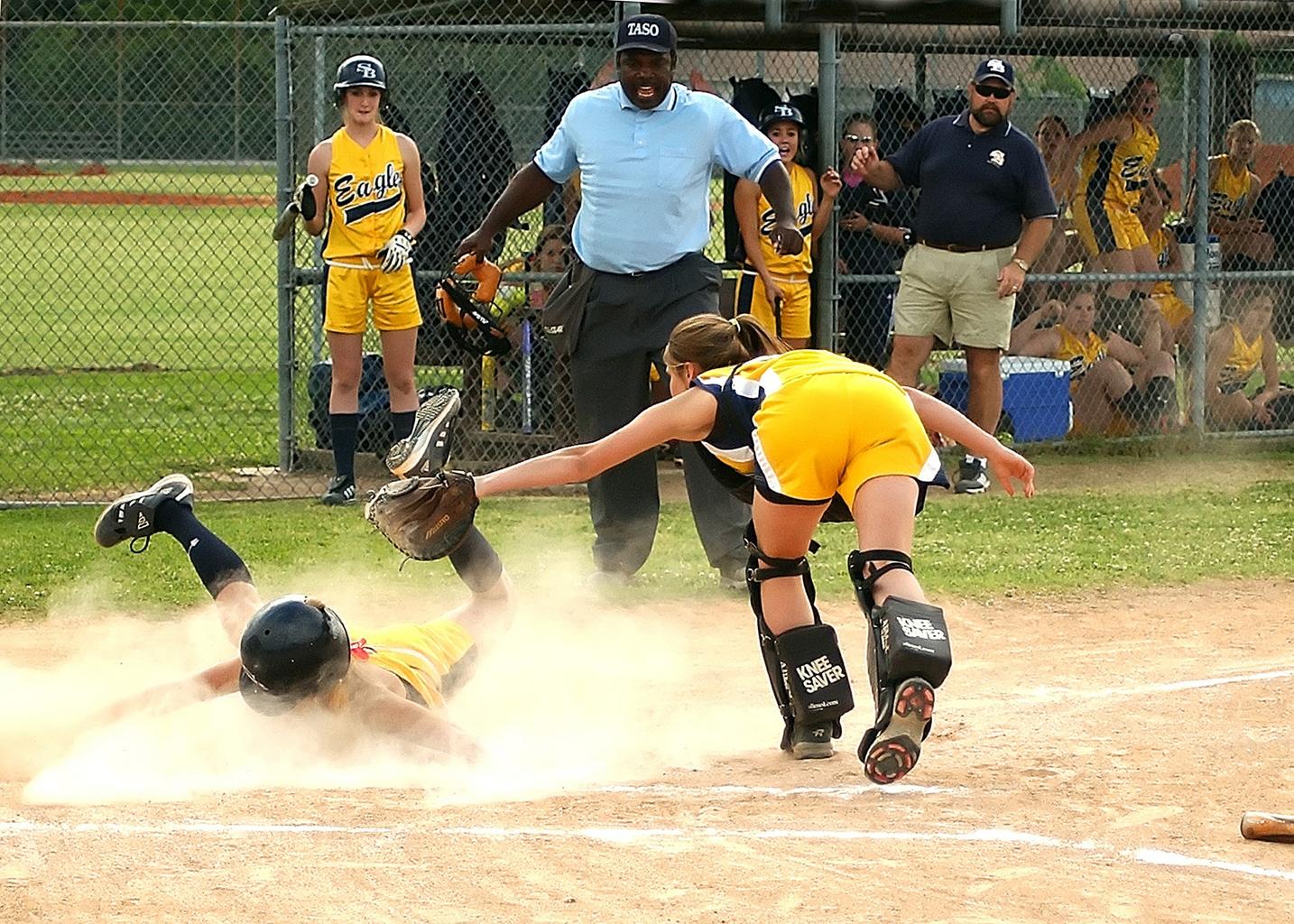
The connection between the pitcher and catcher can make or break a game. When both are in-tune, this can calm down a rattled pitcher, especially in tight games, or ones with important outcomes like placing or winning in a tournament.
Recommended skills for a catcher:
- Strong throwing skills
- Quick reflexes
- Excellent mobility
- good pairing with pitcher, work well together
The catcher position can wear you down if you aren’t able to find a comfortable crouching position. In slowpitch, the catcher needs to be low enough for the umpire to see the plate well enough to call the balls and strikes.
Equipment for the catcher Face mask, (Optional – chest protector, helmet)

The catcher doesn’t need to use a catchers mitt, like they would need to when playing baseball. Instead, an infielder’s glove is suitable for behind the plate.
The Outfield Positions
The slowpitch softball outfield uses four players. Sometimes, the fourth player will move forward and play in ‘the gap’ between the outfield and infield, as a ‘short fielder’.
All outfield positions need players that can run, catch a fly ball and throw the ball back to the infield with accuracy.
When it comes to finding the right glove to use for your chosen position, remember that outfield gloves are longer than infield gloves.
This difference in length doesn’t have the same effect in softball that it does when playing baseball. A baseball has a circumference of 9 inches, whereas a softball can have an 11, 12, or 16 inch circumference.
The decision to use a longer glove in the infield, or a shorter length glove in the outfield, both have advantages and disadvantages, which will be discussed further on an upcoming blog.
Gear for the Outfielder: Outfield Glove
The outfielder glove is longer than the infielder glove. The extra inch or so, provides more room to keep the ball from falling out of the glove once caught.
Left Fielder (LF # 7)
The left fielder covers a huge area, from the back edge of the infield, and all the way to the fence. The left fielder is responsible for catching the long fly ball, sometimes they need to run towards the arc of the ball as it falls downward.
Recommended skills to play Left Field:
- Great hand/eye coordination
- Strong, accurate throws
- Great timing
- Sprinter skills
- Backup throws to 3rd base
Left fielder see a lot of action, and they need to be ready on every pitch. They chase fly balls, and scoop up line drives and ground balls that get past the infielders.
Outfielders, in general,need to be good listeners when two or more players are racing for the fly ball to prevent collision injuries.

Left Center Fielder (LCF # 8)
The left center fielder covers the area similar to the left fielder, with outfielders on their left and right sides. (See field Diagram).
Outfielders have to pay attention when ‘calling’ a fly ball. Some players are so focused on their intent to catch the ball, they don’t hear the other players ‘calling’ them off the ball, and collisions occur.
This happens more often with new players who want to prove their worth, and if not caught early, can result in serious injury at some point in their sports journey.
Skills recommended to play LC Field:
- Attention to detail
- Sprinter skills
- Excellent Glove and agility
- Backup throws to 2nd base
Right Center Fielder (RCF # 9)
Right center field is one of two outfield positions (right field) where new or inexperienced players who can throw accurately, and can catch the ball will play.
This can be a great position for newcomers to the team who may not be as experienced as the rest of the team.
They still need to have the skills to play, and in right center/right field, they won’t feel as much pressure to perform as they might feel if they were at short stop.
Skills recommended to play RC Field:
- Catch and throw the ball
- Attentive
- Understand the game
- Backup throws to right side bases (1st & 2nd)
Right Center fielders can become very defensive players as they get a feel for their position. Overthrows from the infield can cost you the game with runners on base, and by being prepared to retrieve the overthrown ball can prevent more runs from scoring.
Right Fielder (RF #10)
Right field. I can hear the groans from the players and coaches. Many of us know that right field is where we play our least experienced players whose skills are not as strong. That is also the best way for a new player to prove their worth and improve their skills by learning how to play right field.
The right fielder is a very important position.
The player in right field needs to be ready to back up 1st base in case a batted ball gets past them. The right fielder has to be ready to field the ball when batters try to hit to right field in anticipation of safely getting on base.
When the ball is overthrown, the ball is in play unless the ball crosses the foul line. When the ball is loose, runners can advance at their own will until the ball is put into play. As an outfielder, backing up the throw just in case the ball is overthrown, can keep runners from advancing more than one base.
Right field is just as important as other outfields, you might find that right field is perfect for you.
Skills recommended to play Right Field:
- A Positive Attitude
- Throw and catch the ball
- Agility and coordination
- Want to learn how to play better
Right field is the ‘starter position’. You have to start somewhere, and right field is the safest place for you to be until you improve your skills of throwing and catching.
Take time to watch other games to see how their fielders play and talk together while in the field.
Based on where you are located, whether you have four outfielders, or a short fielder between the infield and outfield, the 10th player will be #10 position.
The Final Out
For beginners, start out throwing the ball around. Play catch. get a feel of catching and throwing the ball. Do you like to pick up grounders, or catch fly balls? If you like to run, try an outfield position.
If you are interested in playing softball, no matter your age or gender, then check your local parks to find out if they have softball leagues. Larger cities offer a selection of men’s teams, women’s teams, LGBTQ teams, and Senior teams.
No matter your skill level, if you want to try out for softball, check with your high school or college or neighborhood parks to find out if they have any softball leagues.
Sign up below for more about Slowpitch Softball. If you have any questions, feel free you use the contact form.


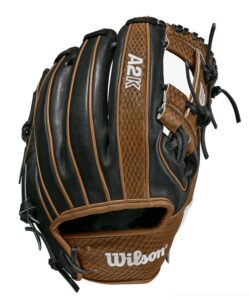

1 thought on “What Are the 10 Slowpitch Softball Positions?”
Wow, this is a great explanation of the softball positions, and the skills needed to play each one. Personally, I’ve played every position at one time or another, where my best years were spent at shortstop, and as I got older, I pitched for a number of years.
Hunter